A more conscious and careful choice of feature prioritization methods is needed!
Dr. András Rung, CEO of Ergomania, gave a presentation in English titled “Choose your features with care” at the eFinance & Fintech Festival 2020 in Budapest.
In the introduction, he talked about the problems possibly arising during development phase, and also about the methods companies and design agencies nowadays trying to employ to find solutions to these snags. Typically, these solutions are either based on the intuitions of executives or copies/stolen ideas from the competitions. It is also common to use marketing studies sometimes even ROI calculations, and if they eventually venture to do some research, they focus on the functions rather than the benefits.
In order to see the situation better – also from the point of view of who were present at the lecture – Dr. András Rung asked the participants to answer one question: “What are the key drivers to chose features in your organisation ?”
Of all the participants in the room 29 responded. Their (grouped) answers are shown in this picture:
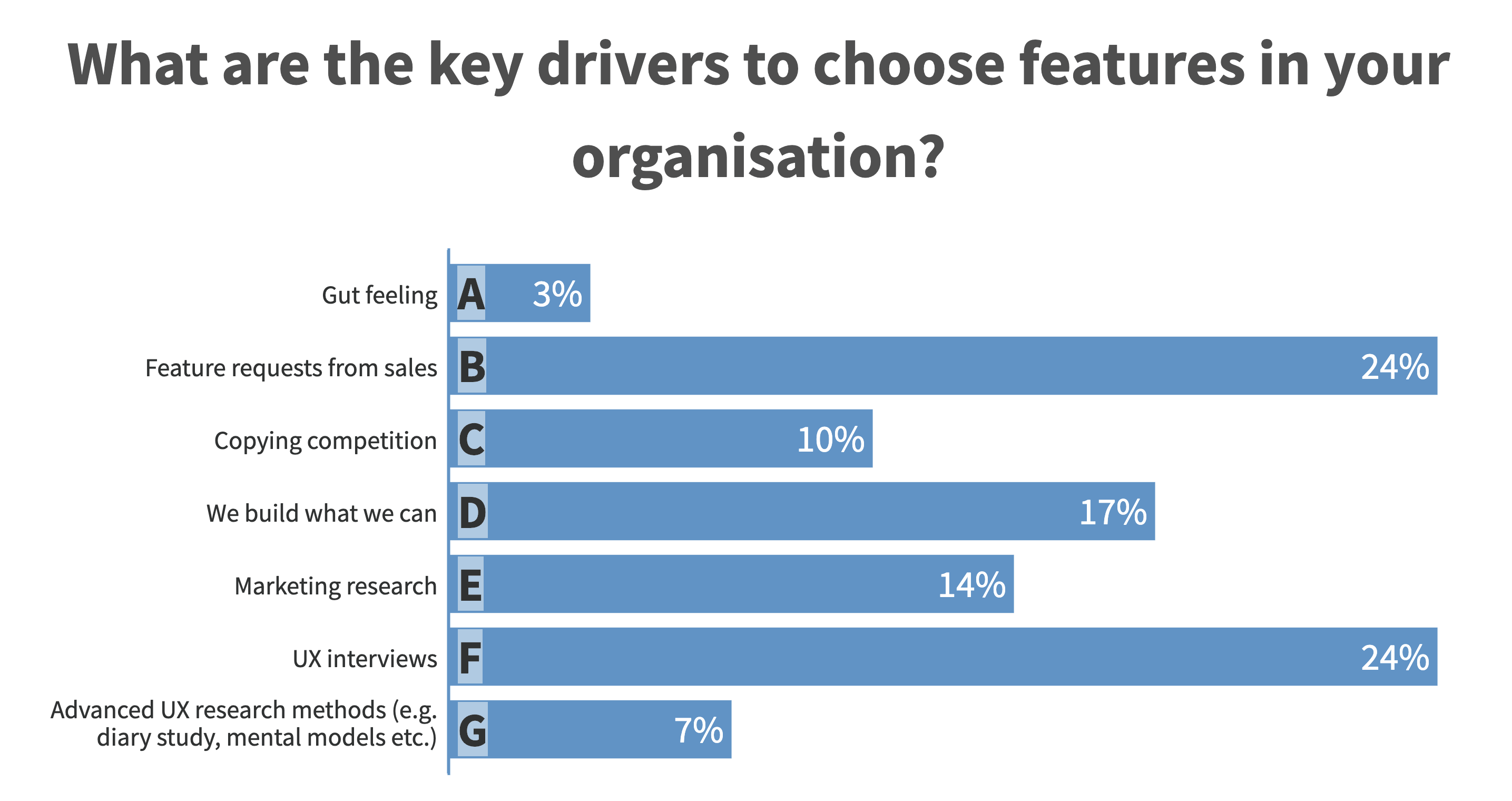
Based on the vote, it is clear that in addition to feature request from sales, user interviews are the best known and also most popular solutions. This is followed by the application of in-house methods (We built what we can), then conducting or commissioning marketing research (Marketing research), drawing from competitor ideas (Copying competition). At the end of this list are advanced UX research methods and executive hunches (Gut feeling).
During the quick analysis of the data collected, Dr. András Rung said that although interviewing users is a well-known solution, and it is great to see that paired up with monitoring of sales data it is in the top 3, it is quite obvious that the more serious, high-level – thus less known – research was in last place. This may be due to the fact that simpler methods are understood and known by many, whereas more complex ones are less known and popular, and would require pre-existing UX-knowledge, which is rarely available in banks just like that.
According to Dr. András Rung, it is safe to say that in general, even if companies do research, the methods they use are in many cases outdated and not innovative enough. Most of them focus on only a few elements, hence they cannot see the whole design/development process. It is also a problem that they are applied sporadically during planning and development, so they also do not give an insight into the expressed and unspoken needs, opinions and preferences of the key players. It is also a common concern that qualitative research, more complex and detailed user interviews and other qualitative methodologies are missing during the development phase. Dr. András Rung readily presented a few key research methodologies that could help in mapping the detailed user needs and ideas in more detail.
Mental model research
He started off by saying that methodologies which are based upon answers given in interviews on user habits and thorough evaluation allows us to assign functions to users’ regular needs. It also helps to omit solutions from development that are only favorites of some members of management but do not address real problems.
Mental models are our ideas that show how we imagine things, how we think about simple or more complex processes. These ideas determine how we start to carry out a given process. They can be applied to both offline and online aspects, and are shaped by our past experiences.
One possible research method for examining mental models was developed by Indi Young. The rather complex procedure has very strict steps. As a result of the study, the researcher maps the mental model of the users about the subject under study and also about the existing interface. Thus, among other things, the difference between the two becomes visible, showing the direction of where and what is worth developing.
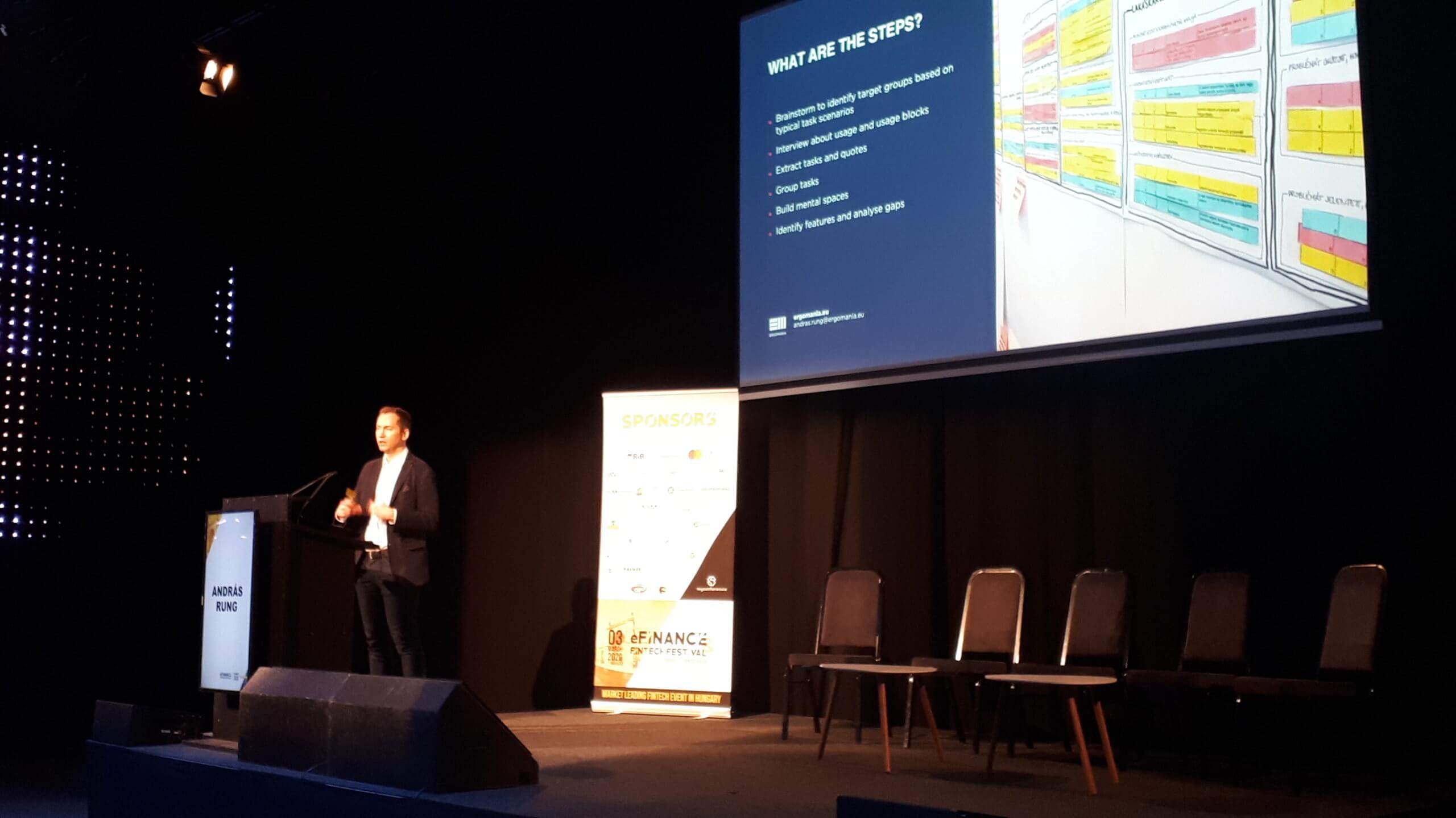
It is also interesting to study mental models when exploring such innovative areas where the field of study is not yet known, hence there is little information available to research participants (so success is critical). Therefore, it is really worthwhile to learn how the participants think about the given area. It is a common experience that although research subjects are uncertain during interviews, it is likely that such a non-conscious, non-reflected mental model will be available that can be quite useful in planning.
The steps of mental models methodology are as the followings:
- Brainstorming to identify target groups, to map typical task scenarios.
- Interview on usage and general behavior (based on questions mapped by brainstorming).
- Data collection, then literal transcription of the recorded answers: we will work with this text later, to extract “tasks”.
- Evaluation of literal transcripts: this is a rather long process requiring unwavering attention consisting of several parts (highlighting and grouping tasks, building “towers”: building “mental spaces”).
- Evaluation of the complete “towers” will lead to identification of the services and analysis of shortcomings.
It is of the utmost importance to realize that mental model research is not just another buzzword in the UX field, but a well thought out research method that can go a long way in making the user experience true to its meaning.
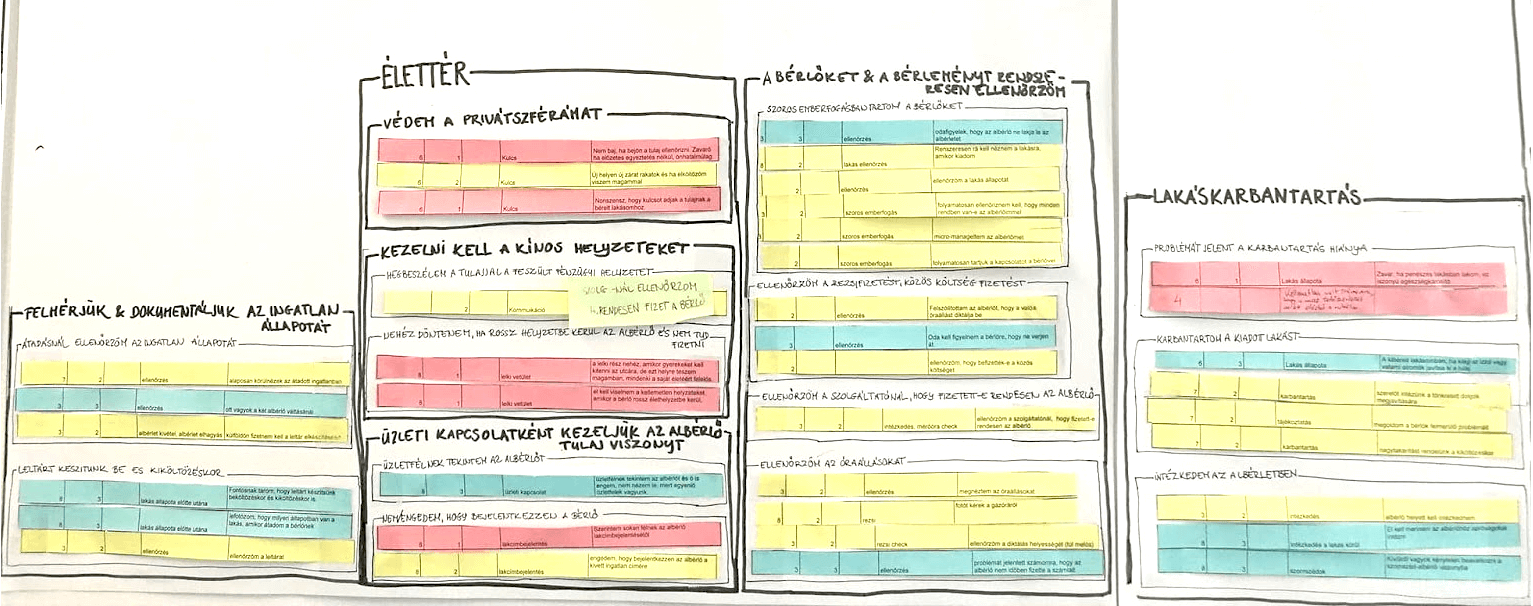
Further information on the theoretical background of the method can be found in Ergomania’s previous posts on mental models (“Mental Images,” Mental and Conceptual Models 1–2), and Indi Young’s book and our review of it.
After the presentation of the study of mental models, Dr. András Rung described the logging data collection (logging or diary study).
Logging can be an excellent data collection solution in the following cases:
- If we are interested in how our users behave in connection with a certain activity during the development of a new interface (e.g. online banking)
- What they do when, we are not with them when carrying out the activity in question (shopping in a webshop),
- What recurring problems they have, what real situations they experience, etc.
To find out more about such cases and problems, we should ask our users to help us by creating a diary based on the criteria we provide. Logging data collection is also a social science research method, the foundations and theoretical background of which can be read in more detail in our blog post on the topic, and in more detail in Csilla Herendy’s article titled 20th Century Methodologies in 21st Century UX Research.
He then presented the Kano model, developed by Professor Kania Noriaki in the 1980s. An excellent solution for measuring customer preferences during product development. The method classifies customer preferences into five categories.
- Must-be feature: Those requirements the customers take for granted. If we perform well, our customers will be neutral, but if we perform poorly or forget about it, our customers will be very dissatisfied. Kano called these requirements “The Must” because excellent performance of these qualities is actually the price of entering the market. In hotels, for example, providing a clean room or toilet paper is a basic need.
- One-dimensional feature: These are the parameters customers usually employ to compare two firms. In case of banks or hotels, location might be such feature.
- Indifferent feature: These traits refer to aspects that are neither good nor bad in the eyes of customers and do not result in either customer satisfaction or customer dissatisfaction. Because consumers are unaware of the distinction, it can be quite important in product design and manufacturing. It is important to identify these qualities in the product or service since their omission can reduce production costs. For example, a landline phone in a hotel room or the “ergonomically tested” aspects of backpacks.
- Reverse feature: These attributes depend to a large extent on the preferences of each customer. Some buyers flat-out reject high-tech features and prefer simplicity. For these buyers, a trait we rate “good” can mean customer dissatisfaction. For example, it is not appealing to everyone when photos reflecting luxury are placed in a hotel catalog, especially if the hotel does not actually meet the expectations. We should also mention the buttons on websites that allow you to accept cookies, complying with GDPR but are hateful to users.
- Attractive feature: These traits, if present, provide satisfaction but their absence do not cause dissatisfaction. Basically, they can’t be expected from a product and service, but if they are included unexpectedly, they make customers happy. They are often not mentioned as a preliminary requirement. This includes when a welcome gift such as a chocolate or candy is placed in a hotel room, the sheets are folded to look like a swan, or when there are candies in a jar placed on the desk at your local bank or unlimited free cookies in the restaurant for kids.
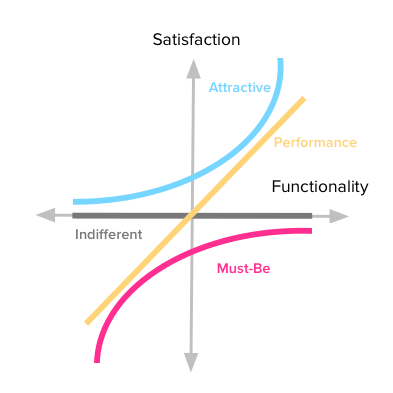
Kano model, aspects
In the case of banking examples, Dr. András Rung emphasized that with the help of the model we can examine the expressed and unspoken needs related to transactions, mobile banking and offline banking. It also becomes assessable how important each aspect is for different personalities. For more on this topic, see an article on the Kano model and Wikipedia on the Kano model.
What is a successful strategy when designing services then?
According Dr. András Rung and Ergomania, it is worth dealing with real situations and problems in a structured way, letting go of unnecessary aspects. If user journey research has been done, it is definitely important to focus on the downs and fix the problems appearing there first. It is worthwhile to provide the product with as many attractive functions and real values as possible and to communicate it properly, but only after the ups and downs of the user journey have been levelled.
At the end of the presentation, András Rung asked the participants which method they would like to try in the light of what they heard.
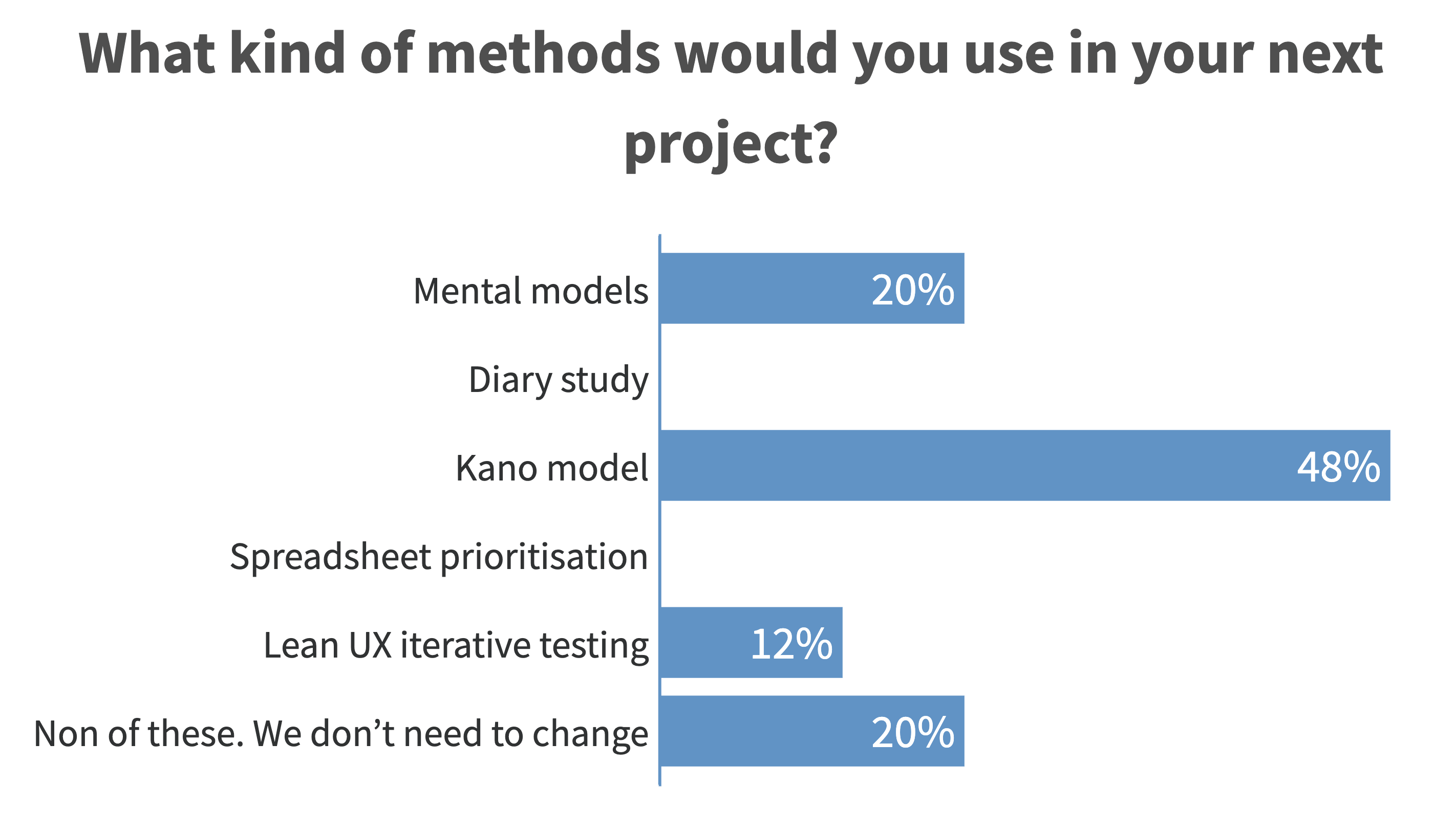
The Kano model received the most votes (48 percent), followed by Mental Model Research (20 percent) and then Lean UX iterative testing. Only 20 percent of participants thought they would be reluctant to use any of the methods in the question. Users would pick the extremely practical but relatively easy to learn Kano model from the methods presented. Mental models aroused much less interest because of its complexity and longer timeframe, but it is encouraging that one-fifth of the participants are willing to give it a shot. If many people would actually try it, there will be a definite effect on the quality of banking products in Hungary!
As a concluding remark, Dr. András Rung drew the participants’ attention to the fact that if we do not want to spend millions on poorly assigned functions based on ad hoc business needs, we need to find a solution that helps us understand our customers’ needs and provides accurate answers to our questions. Applying a well-chosen and well-conducted research methodology can be a safe and valid path to success.
recommended
articles
Find out more about the topic
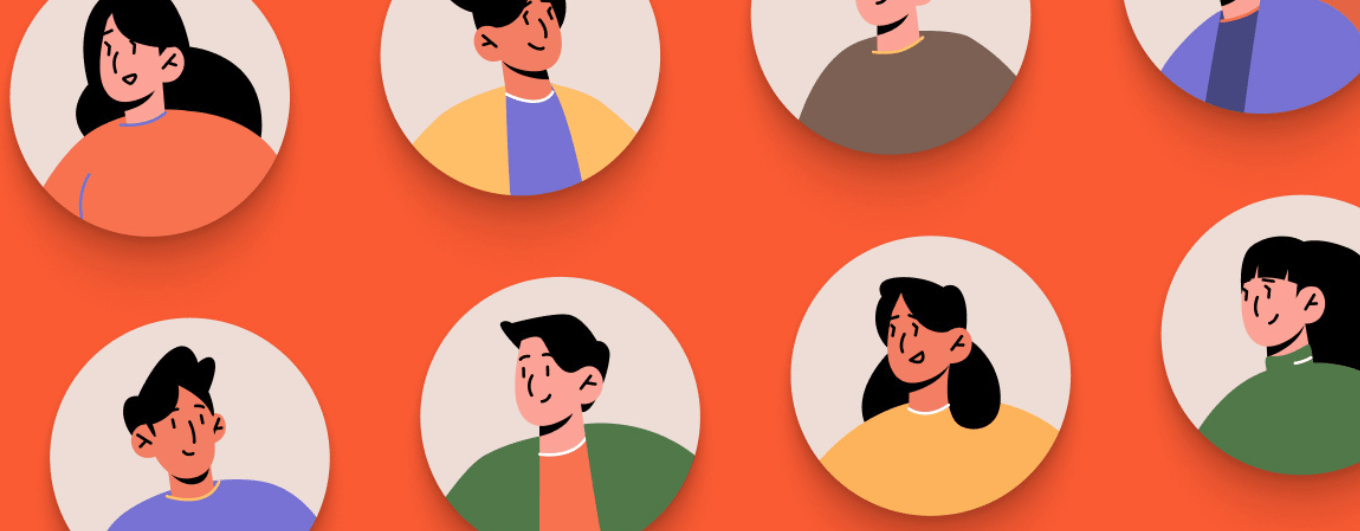



Share your opinion with us